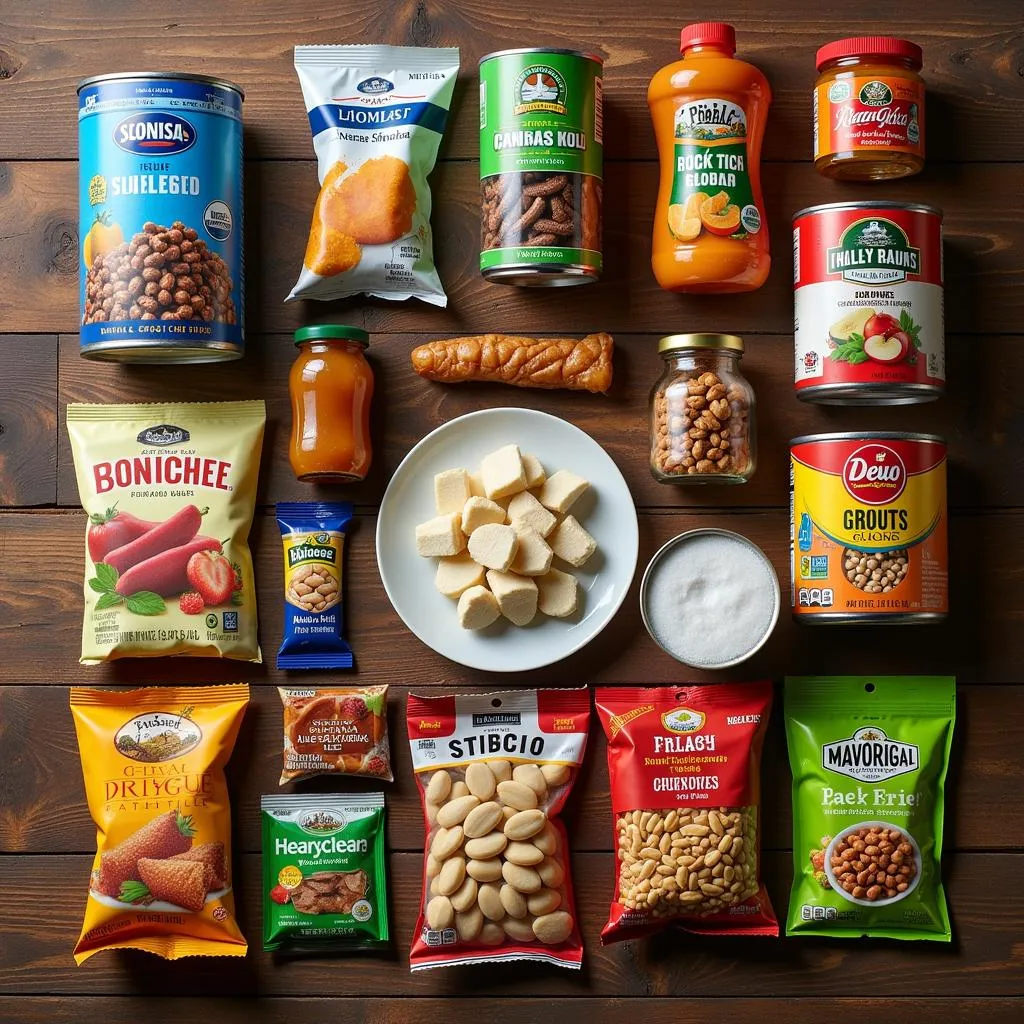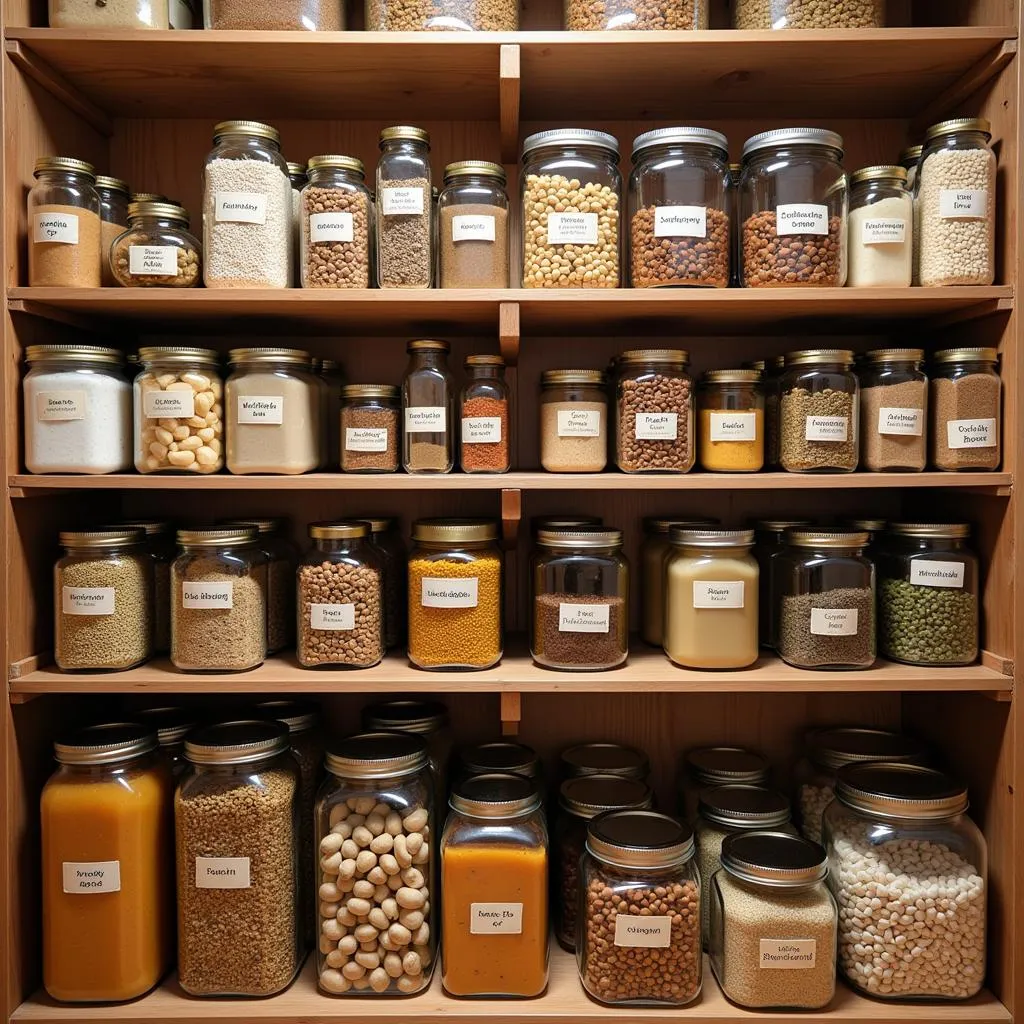Survival food. It’s not the most glamorous topic, but it’s undoubtedly one of the most crucial aspects of emergency preparedness. Whether it’s a natural disaster, economic downturn, or unexpected crisis, having a reliable source of sustenance can be the difference between discomfort and disaster. But what exactly is survival food, and how do you choose the right options for your needs?
 Essential survival food items neatly organized on a wooden table
Essential survival food items neatly organized on a wooden table
Understanding Survival Food: More Than Just Calories
Survival food goes beyond simply packing snacks for a camping trip. It’s about creating a strategic stockpile of shelf-stable foods that can provide vital nutrition in emergency situations. This means prioritizing foods that are:
- Long-lasting: Think years, not weeks. We’re talking about items with extended shelf lives that can withstand time and challenging storage conditions.
- Nutrient-dense: Empty calories won’t cut it. Survival foods should offer a balance of protein, carbohydrates, fats, vitamins, and minerals to keep your energy levels up and your body functioning optimally.
- Calorie-rich: You’ll need enough calories to fuel your body during periods of high stress and potential physical exertion.
- Easy to prepare: In emergencies, simplicity is key. Choose foods that require minimal cooking or preparation, especially if access to resources like fuel or clean water is limited.
Building Your Survival Pantry: A Step-by-Step Guide
Creating a survival food stockpile may seem daunting, but it doesn’t have to be. Here’s a practical guide to get you started:
- Assess Your Needs: Consider the number of people you need to feed and the duration you want to be prepared for. A good starting point is a two-week supply per person.
- Prioritize the Essentials: Begin with staples like:
- Water: The ultimate survival essential. Aim for one gallon per person per day.
- Canned Goods: Fruits, vegetables, soups, beans, and meat provide essential nutrients and variety. Choose low-sodium options when possible.
- Dried Foods: Rice, beans, lentils, and oats are compact, long-lasting, and highly versatile.
- Nuts and Seeds: Packed with protein, healthy fats, and essential nutrients, these are great for snacking or adding to meals.
- Dried or Canned Meat: Tuna, salmon, chicken, and beef jerky provide protein and can be eaten on their own or added to other dishes.
- Powdered Milk and Milk Alternatives: Shelf-stable sources of calcium and other essential nutrients.
- Honey or Sugar: Natural sweeteners and energy boosters.
- Salt: Important for flavor and electrolyte balance.
 A well-organized survival pantry with labeled shelves and containers
A well-organized survival pantry with labeled shelves and containers
- Consider Special Dietary Needs: Allergies, intolerances, and medical conditions should be factored into your selections.
- Don’t Forget Flavor: Survival food doesn’t have to be bland. Stock up on spices, herbs, hot sauce, and other flavor enhancers to make your meals more enjoyable.
- Rotate Your Stock: Regularly check expiration dates and use a “first-in, first-out” system to ensure freshness and prevent waste.
Beyond the Basics: Enhancing Your Survival Food Plan
Once you’ve covered the essentials, consider these additional tips to elevate your survival food strategy:
- Grow Your Own: Even a small herb garden or a few tomato plants can supplement your stockpile with fresh produce.
- Learn Basic Food Preservation: Canning, pickling, and dehydrating can significantly extend the shelf life of seasonal fruits and vegetables.
- Invest in a Water Filter: This ensures access to clean drinking water, even if bottled sources are unavailable.
- Pack a Portable Stove: A camping stove allows you to cook or heat food even without access to a conventional kitchen.
Expert Insights: A Word From the Wise
“When it comes to survival preparedness, knowledge is just as vital as supplies,” says Sarah Williams, a certified wilderness survival instructor. “Familiarize yourself with different food preservation techniques, practice cooking with limited resources, and learn to identify edible plants in your area. These skills can be invaluable in a crisis.”
FAQs: Addressing Your Survival Food Questions
1. How often should I rotate my survival food?
Aim to rotate your stock every 6-12 months, depending on the specific shelf life of each item. Always follow the manufacturer’s recommendations for storage and consumption.
2. What are some good survival food options for picky eaters?
Focus on familiar favorites with long shelf lives, such as peanut butter, dried fruit, crackers, and canned soups.
3. Can I include comfort foods in my survival kit?
Absolutely! Familiar treats can provide a much-needed morale boost during stressful times. Just be mindful of their shelf life and nutritional value.
Navigating Uncertain Times: The Importance of Being Prepared
In a world where the unexpected can unfold at any moment, taking charge of your well-being through thoughtful preparation provides invaluable peace of mind. By building a strategic survival food stockpile, you’re not just storing supplies; you’re investing in your resilience and the well-being of those you care about. Remember, knowledge is power. The more you learn about survival preparedness, the better equipped you’ll be to navigate challenging situations with confidence.
For personalized guidance and support in creating your ultimate survival food plan, contact Mina Cones Food at Phone Number: 02437655121, Email: minacones@gmail.com. Visit our store located at 3PGH+8R9, ĐT70A, thôn Trung, Bắc Từ Liêm, Hà Nội, Việt Nam for expert advice and a wide selection of high-quality survival food supplies. Our dedicated team is available 24/7 to assist you.